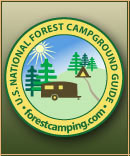Forest Information
The Apalachicola National Forest, comprised of 564,961 acres on
gently rolling flat terrain, is located southwest of
Tallahassee, FL. Of the thirty-nine developed campgrounds, three meet
the selection criteria.
The Apalachicola National Forest, the largest National Forest in Florida, was established in 1936 on land that was in poor condition due to timber and turpentine producing practices. Today, the Apalachicola is a healthy, productive forest with numerous camping locations scattered throughout this National Forest. Some of these locations are called "dispersed" meaning sites are undeveloped by the Forest Service. (Dispersed camping locations are not included in this campground review and visitors should contact the Forest Service for more information about them.) There are also "hunt camps" which are much like "dispersed" sites except port-a-pots are provided during deer hunting season. Than there are the Apalachicola National Forest's developed campgrounds where campsites are designated and various amenities provided. But there is more to this Forest than just camping. There are the natural features, such as Apalachee Savannahs and Leon Sinks, and man-made places, like Fort Gadsden and Munson Hills Off-Road Bicycle Trail, to explore and enjoy.
Apalachicola National Forest provides a view of an ecosystem unique to Florida that includes longleaf pines, wire grass, savannahs, and wetlands. Leon Sinks Geological Area, an easy drive from Silver Lake Day Use area U.S. Route 319, is an example of a "karst plain." The area contains several wet and dry sinkholes, numerous depressions, a natural bridge, and a disappearing stream accessed by three different trails.
The National Forest's Apalachee Savannahs Scenic Byway, State Route 379, passes through a flat to gently rolling landscape of moist lowlands. There are bays of magnolia and cypress trees to explore as well as one of the largest tracts of natural Longleaf pine and wiregrass in existence. Savannahs are marked by grassy open areas which are always wet-to-moist. Such conditions are important to the health of a variety of wildflowers, such as orchids, pitcher plants, and sundews. Hickory Landing campground, with access to Apalachicola River, and Wright Lake campground, with views of the Lake, are just off the Byway and offers campers a great opportunity to captures the color and natural beauty of the Apalachee Savannahs in a series of national forest pictures. Such photographs, along with camping pictures, help keep memories vivid.
Another way to explore the Apalachicola National Forest is via Munson Hills Off-Road Bicycle Trail. Located in the eastern side of the forest, near Leon Sink, the Trail is a scenic and challenging ride through rolling terrain. Riders climb sandhills covered by longleaf pine and wiregrass and dip down into the shady valleys of hammock ecosystems. Riders are warned to be alert to the abundant wildlife in the area.
For history or Civil War buffs, a visit to Fort Gadsden Historic Site, just off the Alalachee Savannahs Scenic Byway, is a must. Fort Gadsden has been part of Florida's history since the early 1800's. Originally built by the British as a base for recruiting Native and African Americans during the War of 1812, it was abandon in 1815. At the time, Garcon, a Black military leader, assumed command of the Fort. On July 27, 1816, Col. Duncan Clinch from Fort Scott in Georgia attacked what had become known as the "Negro Fort." The Negro Fort was taken after a bloody bombardment. In 1818, Andrew Jackson instructed Lt. James Gadsden (for whom the fort is now named) to build new fortifications at the Negro Fort site as a supply base. Lt. Gadsden maintained the Fort until 1821. After that, Fort Gadsden was virtually forgotten until 1862 when the Confederate Army took control of the Fort. Via the Apalachicola River, it was a supply resource for Confederate troops in the north. After the Civil War, Fort Gadsden faded into history. Today, a tour of the Fort provides visitors with insight to life at a 19th century fort and a taste of that lifestyle.
The Apalachicola National Forest is an interesting blend of recreational opportunities, camping locations, history, longleaf pine forests, savannahs, and cypress ponds. It is this diversity that attracts visitors back time and time again to the Apalachicola National Forest.
ADDRESSES
SUPERVISOR ADDRESS
325 John Knox Rd.
Building F, Suite 210
Tallahassee, Florida 32303
850-523-8500
RANGER DISTRICT ADDRESSES
Apalachicola
11152 NW State Route 20
Bristol, Florida 32321
850-643-2282
Wakulla
57 Taft Dr.
Crawfordville, Florida 32327
850-926-3561 |
